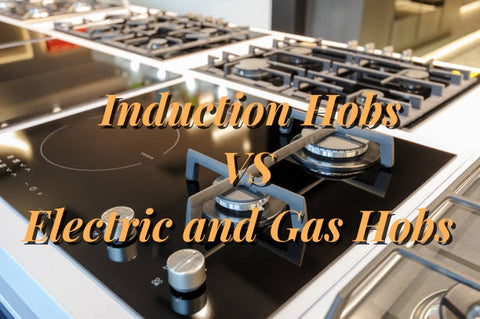There are three major cooktop types on the market, induction, electric and gas. If you’re considering updating your kitchen, you’re probably wondering which type of cooktop is right for you. The right choice depends on what makes you feel more comfortable, the best option for your cooking style and a few other factors.
Curious about the difference in induction cooktops, electric cooktops and gas cooktops? You can learn more about the significant differences here.

Induction hob vs Electric hob
Electric cooking is slightly more like induction cooking than gas, but there are many distinctions between induction stoves and electric. Unlike gas, most induction or electric ranges do not require any particular kind of hookup beyond a 220-240v outlet. However, induction gives a chef more direct control over the heat level than electric; when a pan is used for induction cooking, its temperature changes the moment the current is adjusted. This is not the case for electricity, as it takes time for the pan to catch up with the temperature of the heat source.
While electricity is certainly more energy-efficient than gas, induction is still the clear winner for efficiency. Stovetop or cooktop electric cooking allows only 65-70% of the heat to reach food as opposed to induction’s 90%. This results in your kitchen staying cooler with induction than with electric cooking. While fire risk is lower with electricity than with gas, the risk is still lower with induction. Since the pan is the only heat source in induction cooking, your risk of kitchen burns is also significantly decreased.
Induction hob vs Gas hob
A significant difference between a gas and induction stovetop is that induction is significantly more efficient than gas – food cooked with induction will receive 90% of the heat generated instead of only 40 to 55% for gas. This keeps your kitchen much cooler and more comfortable while you prepare meals. Induction cooking also decreases the risk of burns and accidental fires, as there is no open flame and the cookware itself is the only heat source.
Pros & Cons of the induction hobs, electric hobs and gas hobs
Induction hob advantages:
Safe
They are safe as the heating element emits no radiant heat except through appropriate metals, but transient heat will still culminate around the cooking area. The residual heat is little to none and will dissipate quickly (though it is never recommended to place your hands, limbs, or bodily parts near any heat-generating source).
Cooler Kitchen
Same as their traditional electric counterpart, induction elements produce no heat at all unless through the transference of magnetic metals, so they are exceptional at maintaining a cooler room temperature
No Wasted Heat
Induction cooking wastes no heat and will operate more economically than traditional electric heating elements.
Pollutant Free/ Climate Friendly
Induction stoves do not emit any toxic gases into your house. Induction stoves use clean electricity and emit far less CO2 emissions than gas-powered stoves.
Induction hob disadvantages:
Depends on Electricity
Like an electric range, induction also relies on electricity to work. If no electricity is supplied to your home, induction ranges/cooktops will not work.
Expensive
Induction ranges and cooktops are typically a little more expensive to purchase compared to the other options.
Requires Conductive Cookware
Induction cooking requires appropriate cookware, typically anything containing iron. It will not work on anything else, including aluminium, glass, or copper.
Electric hob advantages:
Easy to Clean
The convenience of a smooth top electric range/cooktop is easy to clean with no indents or crevices present.
Cool Kitchen
Electric heating elements do not generate much ambient heat and will maintain a cooler kitchen.
Inexpensive
Electric ranges/cooktops are also considerably less expensive compared to their gas counterparts.
Electric hob disadvantages:
Depends on Electricity
In the event of an electrical outage, electric ranges/cooktops will not work.
Retains Heat after Shutoff
Electric elements can get hot and retain high heat levels even after being turned off. They cannot cool down as quickly as gas burners.
Easy to Damage
Although a smooth top electric range/cooktop is easier to clean, it requires routine maintenance. Smooth tops are susceptible to scratches, and ceramic can crack if cold water touches it while hot.
Gas hob advantages:
Versatility
Gas ranges/cooktops will work in the event of an electrical outage by using a match or lighter to ignite the gas flow.
Precision
Gas output is a little more precise in control as the flame output is quickly and easily adjusted in real time.
Fast
Gas heat is immediate and powerful from the ignition, but electricity tends to heat food faster in comparison in some cases.
Gas hob disadvantages:
Hard to Clean
Cleaning requires a bit more effort as there are grooves and crevices around the burners. Including the removal of burner grates, cleaning can be an ordeal.
Hot Kitchen
Gas hookup ranges/cooktops emit radiant heat and emanate throughout the kitchen, which could be uncomfortable for small kitchens.
Cost
Gas operational costs are more expensive as a fuel source compared to electricity. Especially true if the gas range is a pilot light model, which requires a constant gas flow.
Emissions and Pollution
Gas stoves are a significant source of indoor air pollution, emitting nitrogen dioxide (NO2), carbon monoxide (CO), and formaldehyde (HCHO) into your home, all of which can have adverse health effects and exacerbate respiratory conditions such as asthma.
Conclusion
What’s not to like about induction cooking? Induction offers a safer, faster, more efficient, and climate-friendly way to cook your food than electric and gas-powered cooking. Using induction cooking is a great way to lower levels of harmful pollutants in your home, lower your carbon footprint, and contribute towards fighting climate change.

